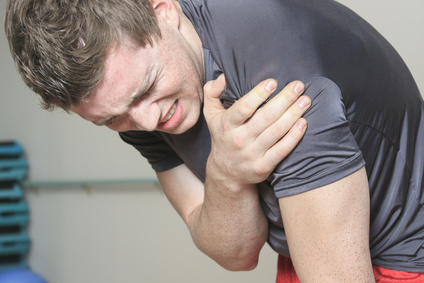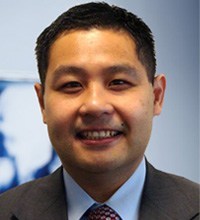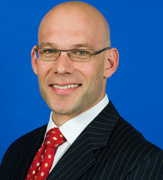Torn acromio-clavicular ligaments are the most common form of shoulder injuries. They are most commonly associated with young, athletic adults involved in throwing sports, collision sports, and overhead exercises such as extreme strength training.
Approximately 3% of all shoulder injuries involve torn acromio-clavicular ligaments, and 40% of sports injuries to the shoulders involve these ligaments1.
The shoulder comprises of several small joints located outside the socket of the arm bone:
- The scapula (triangular shoulder blade), called the scapula
- The acromion (bony knob at the top of the scapula), called the acromion
- The clavicle (collarbone)
- The sternum (breastbone)
These four bones are connected by a series of ligaments. Shoulder ligament tears typically occur between the acromion and collarbone, also referred to as the acromion-clavicular joint (AC joint). This sprain is frequently called a ‘shoulder separation’.
The acromion-clavicular ligament and coracoclavicular ligament support the acromion-clavicular joint. These ligaments are located near the shoulder at the outside end of the collarbone. They are responsible for binding together the collarbone and shoulder blade. These ligaments are very strong and it requires a lot of force to tear the acromio-clavicular ligaments.
The following video explains the structure of the shoulder joint and associated ligaments.
Contents
- 1 Causes of torn acromio-clavicular ligaments
- 2 Prevention and recovery
- 3 Nutrients supporting ligament recovery
- 4 References
Causes of torn acromio-clavicular ligaments
The most common causes of shoulder injuries involving tearing the acromio-clavicular ligaments are direct, strong blows to the top or front part of the shoulder, or trauma from a hard fall. Colliding with an object may also result in this injury.
People who participate in contact sports or high velocity activities such as jet skiing, alpine skiing, rugby, football, or wresting most commonly experience acromio-clavicular joint sprains. Athletes in their 20’s and 30’s are more commonly affected, with men twice as likely to experience this form of injury2.Car accidents and bicycle falls can also result in torn acromio-clavicular ligaments.[/vc_column_text][/vc_column][/vc_row]
Signs, symptoms and diagnosis of torn acromio-clavicular ligaments
Like most ligament injuries, torn acromio-clavicular ligaments are classified into three different grades depending on the severity of the injury:
Grade 1
The acromio-clavicular ligament is slightly torn but the coraco-clavicular, its companion ligament, is uninjured. Consequently, the acromio-clavicular joint remains joined tightly.
Grade 2
The acromio-clavicular ligament is totally torn and there is a partial tear of the coraco-clavicular ligament. In this situation the angle of the collarbone is slightly out of place.
Grade 3
Both the coraco-clavicular and the acromio-clavicular ligament are completely torn. There is obvious separation of the collarbone.
Signs and symptoms of a Grade I acromio-clavicular ligament sprain include tenderness and swelling around the outside tip of the collarbone. Arm movements and shrugging of the shoulder will cause mild pain.
More severe acromio-clavicular sprains will result in swelling that distorts the joint contour, leaving the shoulder very tender. Significant pain will be noticeable when moving the affected arm or touching the joint.
In some cases doctors may assess severe acromio-clavicular ligament sprains higher than Grade 3, from grades 4 to 6. With each higher classification, the collarbone is further displaced from its normal position and the deformation of the shoulder is more severe:
Grade 4
Similar to a Grade 3 injury with with the coraco-clavicular ligament forced away from the clavicle. There is posterior displacement of the distal clavicle into or through the trapezius.
Grade 5
Like Grade 3 and 4, except there is great exaggeration of clavicle vertical displacement away from the scapula-coraco-clavicular interspace, up to 300% more than normal, with subcutaneous positioning of the clavicle.
Grade 6
A rare classification, this is a form of type 3 acromio-clavicular ligament sprain with characterised by inferior dislocation of clavicle at the lateral end below the coracoid.
The following video shows various grade classifications for torn acromio-clavicular ligaments
During the physical assessment, a doctor will examine and compare both shoulders. Shape differences, swelling, bruising or abrasion will be noted, along with changes in motion of the sterno-clavicular and acromio-clavicular joints. The doctor will assess the ability to perform a range of motions and pain threshold.
As there are important nerves and blood vessels that occur in the shoulder region, the examination will also include and assessment of pulses at the elbow and wrist, skin feeling in the fingers, hand, and arm, plus muscle strength.
If a fractured bone or severe shoulder sprain is suspected following a physical examination, x-rays will be requested. Computed tomography (CT) scans or magnetic resonance imaging (MRI) scans may also be required depending on the extent of the injury.
Treatment options for torn acromio-clavicular ligaments
The treatment for torn acromio-clavicular ligaments will depend on the severity of the injury. Grade 1 and 2 injuries usually respond well to rest. The arm will usually be placed in a sling for one to three weeks and treated with ice and pain relief drugs such as a nonsteroidal anti-inflammatory.
A similar approach is usually taken to Grade 3 injuries, although the arm will be in a sling for longer, usually at least four weeks. In some cases, a Grade 3 sprain may need surgery. This is usually the case for people where the collarbone is displaced by in excess of 2cms. Surgery may also be recommended for very young people or adults that are required to do a lot of heavy lifting as part of their employment.
The long-term outlook for Grade 1 and 2 injuries is positive. However, up to 40% of people that have experienced this type of ligament strain will report mild lingering symptoms, such as pain during shoulder exercises or a clicking sensation when moving their arm.
Within one to two weeks most people are able to move their shoulder again without discomfort after suffering from Grade 1 or 2 tears, although it can take up to six to eight weeks to return to normal athletic activity.
For people with Grade 3 ligament injuries usually they can return to work within four weeks. However, athletes have a much higher risk of reoccurring injury and may need between three and five months of rehabilitation before being able to return to their sport.
Grade 4 to Grade 6 injuries account for up to 15% of all acromion-clavicular dislocations and require surgical management. If not treated correctly, the patient will experience ongoing chronic pain and shoulder dysfunction.
Torn acromio-clavicular ligament surgery
Surgery to repair AC joints can take the form of anatomical or non-anatomical. Historically there have been four different approaches:
Distal clavicuar excision
Also known as a mumford procedure, this technique help to alleviate inflammation and remove any bone and/or bone spurs. This is also a common procedure for people suffering from arthritic shoulders.
Acromio-clavicular repair
An intra-articular repair, the aim is to reconstruct the damaged ligaments using pins, screws, plates, or sutures.
Coraco-clavicular repair
A range of surgical methods may be applied, including Bosworth screws, Cerclage, or a Copeland and Kessel repair.
Dynamic muscle transfers – Transfer of a muscle-tendinous area to the inferior surgace of the clavicle. The result is an inferiorly directed force exerted onto the distal clavicle, which actively reduces the AC joint.
This technique is not often used because there are many potential complications including persistant joint instability, mal-union and non-union of the graft, possible musculocutaneous nerve damage, and potential excessive AC joint motion which could lead to further damage.
Surgical approach depends on individual circumstances
Although there are different proposed surgical approaches to treating AC joint injuries, there is no consensus on the superiority of one procedure over another. There are those that seek to fix the injury, while others propose to reconstruct or augment the ligaments.
Although dynamic muscle transfers have been used, this technique has not been shown to have long-term positive results3.
Prevention and recovery
It’s very difficult to prevent torn acromio-clavicular ligaments if participating in high-impact activities. Their is always a risk of causing damage to the AC joint.
However, as the majority of injuries are minor, recovery is typically fast. It’s important to rest the should and follow doctors instructions.
Keeping the shoulder strong and maintaining the full range of motions can help to better protect from injuries.
Nutrients supporting ligament recovery
Resting the shoulder is essential for helping the acromio-clavicular ligaments, regardless of whether or not surgery has been required. Once healing is underway, light exercise as directed by a doctor or physiotherapist will help to improve shoulder function.
A good nutrient-rich diet is also essential, as this can help to speed up recovery and strengthen the ligaments. Certain trace elements, vitamins, and minerals can reduce inflammation and promote healing. Some of these key nutrients include omega-3 fatty acids, vitamin C, zinc, and copper.
Foods rich in antioxidants can reduce cellular stress on the AC joint, helping to accelerate repair. Maintaining a healthy diet and/or taking quality supplements is an important part of the recovery process.
References
- “Rockwood, C. et. al. (1996). ‘Injuries of the Acromioclavicular Joint.’ In CA Rockwood Jr, et al (eds), Fractures in Adults. Philadelphia: Lippincott-Raven, 1996; 1341-1431.” ↩
- “Dias, J. and Greg, P. (1991). Acromioclavicular joint injuries in sport: recommendations for treatment. Journal of Sports Medicine, Volume 11, (pp.125-32).” ↩
- “Skjeldal, S et. al. (1988). Coracoid process transfer for acromioclavicular dislocation. Acta Orthop Scand. Volume 59, Issue 2, (pp.180-2.).” ↩






